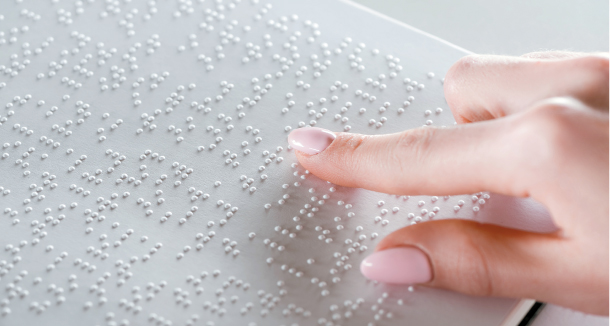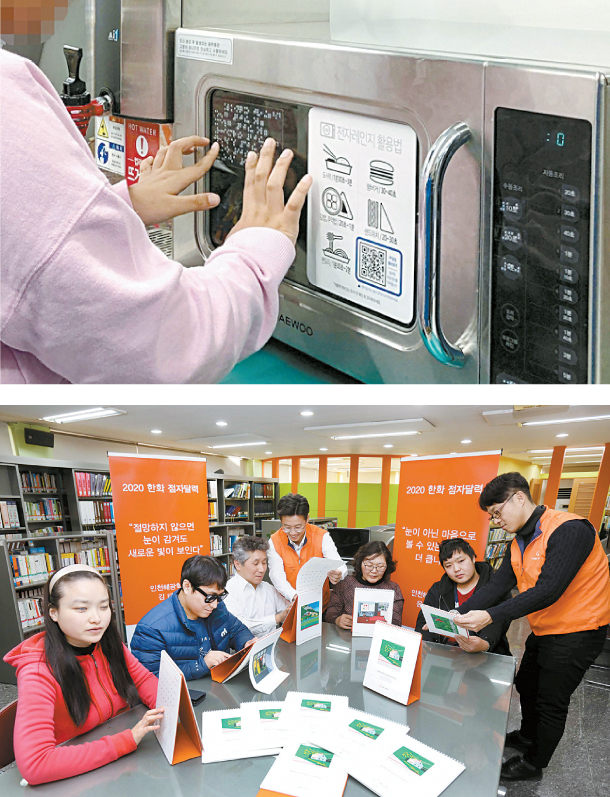Inclusive design gives the blind independence: Folks with disabilities often find that tech forgets their needs

Unmanned and automated kiosks at hamburger joints, for instance, free employees from having to take orders from customers. Instead, they could use that saved time on prepping vegetables in advance.
Some see the technology as a blessing, but others find it to be a disaster.
“Advanced technology may seem more convenient to those with physical disabilities, but in reality the technology doesn’t promise a better world all the time,” said Lee Byeong-don, the head at the Korea Disabled Consumers’ Union (KDCU).
“There are a myriad of digital products that you can operate with a few touches but they are useless for the visually impaired.
“The latest electric rice cooker from a local company boasts that it has 18 different functions and you can operate it with a single digital push button, but it is nothing for people like us,” Lee added.
Electronic devices loaded with artificial intelligence also may look handy for the blind, but most of the products are activated with voice only in the beginning and later require touch, causing blind users to eventually give up.
The list of similar inconveniences that the visually impaired experience daily goes on and on.
“Someone I know, a blind person, checked in at a hotel, and he later found out that he had dabbed shampoo on his face,” Lee said.
“We have very few products that provide braille labels in the market, so it’s never easy for blind people to tell the difference between similar products using only their sense of touch,” Lee added.
Everyday rituals such as going grocery shopping or placing an order at a restaurant are daunting tasks for the blind, too.
To make matters worse, a growing number of restaurants, banks and hospitals have installed unmanned, automated kiosks.
It comes as no surprise that the visually impaired often miss their turns without knowing that their numbers have flashed on screens in the facilities. Without personal assistants, many struggle to find ways to cope with the changes.
Lee from the KDCU shared one more anecdote.
“It’s not easy to buy a can of beer. All the canned beer has braille labels on the top, but it just reads beer. You have no idea what brand it is. You can’t really know whether it is a domestic beer or an imported one. They just sort out beverages into three: beer, fizzy and non-fizzy drink.”
Adding braille labels to more products has been a long-standing issue in politics.
The Braille Act came into effect in Korea in May 2017. Under the act, which was put in place for the purpose of enhancing the quality of life for the blind, 14 non-legally-binding recommendations were made.
Lawmaker Rep. Park Myung-jae from the former Saenuri Party proposed some revised bills that mandated braille labels on medicines, cosmetics and health foods in 2015. Similar bills were proposed by another lawmaker Rep. Yun So-ha from the Justice Party in 2017, but they did not pass the National Assembly.
“I proposed it for the sake of safety for the blind community, but I feel sorry that it is still pending,” said Yun.
Fortunately, however, more private companies and the public sector are becoming more aware of the issue. And many are approaching the issue as a matter of inclusive design.

Top: Local convenience store chain GS25 made some branches friendly for those who are visually impaired. The way to use the microwave is explained in braille dots at one of its stores. Above: Hanwha Group has produced braille calendars for the past 20 years. [GS25, HANWHA GROUP]
Basic concepts are similar, but inclusive design goes further than universal design and focuses on everybody.
Regardless of age, gender and language, everyone should be able to use various products and have access to facilities and services without being excluded.
Inclusive design works for all with the tagline of “If the disabled find it comfortable, the non-disabled will find it comfortable as well.”
Low-floor buses without stairs or products with braille labels are examples of inclusive design.
Gongju, South Chungcheong, recently began to provide braille labels for some medicines. The braille stickers notify people of possible side effects that could be caused by specific drugs. The stickers also contain information of don’ts when taking certain medicines so that the blind can take drugs independently.
Private companies have joined the bandwagon as well.
The country’s beauty conglomerates Amorepacific and LG Household & Health Care have added braille dots to some of their products so that their customers can tell the difference between shower gels and shampoos.
Local cosmetics manufacturer Dr. Different is more enthusiastic about making its products friendly for the visually impaired.
The company added braille dots to all of its 18 product, not only on the package boxes, but also on the containers starting April.
“We try to elaborate on details depending on skin types so that consumers [who are visually impaired] can opt for suitable products depending on their needs,” said Lee Dong-won, the head of the Dr. Different.
“We don’t think of this as a one-time only event. We hope this would encourage other companies to join in,” he added.

Products that include braille labeling from top: a blouse, a Coca-Cola can and an air purifier. [HELLO MAL, JOONGANG ILBO]
Detailed instructions on how to use microwaves and the location of trash bins are written in braille letters at the specific convenience store locations.
Hanwha Group has been producing braille calendars for 20 years and distributes them for free.
More innovative attempts are made by young entrepreneurs.
An Hye-jin, Kim Su-hyeon and Lee Mu-bi established the start-up Hello Mal and initiated an upcycle clothing project about a year ago.
They carried out a couple of projects such as a wedding gown rental service for single mothers and clothing reform education for children from low-income families. They eventually developed an interest in blind women who couldn’t choose what to wear without help from others.
“We used to donate clothes to associations for the blind and then we came to know about difficulties some blind people go through,” said An.
“They can buy some clothing with braille labels through international shopping, but they are way too expensive. A T-shirt costs 70,000 won ($58.70). That’s why we embarked on this project.”
There was some trial and error in the beginning.
“We attached the braille labels underneath the collar, but people who tried out our clothes said they could feel the braille dots on their skin and it was annoying. We eventually moved the dot labels from the neck to the hem of sleeves,” An added.
The volume of information included in the label was cut down, too.
Information about materials, colors and patterns were included on a single label in early stages.
“The braille dots are quite big so it was hard for us to put all the information on a label. In addition, most of the blind people have a good sense about fabrics and materials; they just know what clothes are made of just by touching it. We ended up adding information only about colors or patterns,” An said.
The efforts of Hello Mal was recently recognized by the Korea Central Council of Social Enterprise. The clothing with braille labels received the grand prize last month at the Social Economy Contest, an annual contest for start-ups which come up with products or services that come in handy for minorities.
Hello Mal plans to launch its clothing with braille labels early next year. The company said the price range will be between 15,000 won and 30,000 won for a single item.
BY KO SEONG-PYO, SUNG SO-YOUNG [estyle@joongang.co.kr]
샴푸인지 화장품인지…시각장애인에게 ‘구별’을 허하라
“기술이 발전하면 이전보다 장애인에게 더 편리한 세상이 찾아올 것 같지만, 현실은 꼭 그렇지만은 않더라. 손가락 터치 몇 번으로 제품이 작동되는 가전제품이 홍수를 이루지만 시각장애인에게는 넘어야 할 또 다른 장애물이다.”
이병돈 한국장애인소비자연합 대표의 말이다. 이 대표의 얘기를 더 들어보자. “터치 제품이 많이 나온 뒤로 바보가 돼 가는 느낌”이라며 “가령 최신 OO 압력밥솥의 경우 버튼 하나로 18가지 기능을 조작할 수 있다는데 자동세척을 하려면 16번의 조작이 필요하다. 우리 같은 시각장애인에게는 무용지물이나 다름없다”
실제로 인공지능 가전제품도 음성으로 작동돼 편리할 것 같지만, 음성지원이 시작 단계에만 실시되고 다음 단계부터는 터치해야 해서 중간에 포기하기 일쑤다.
시각장애인들이 일상생활에서 어려움을 겪는 사례는 전자제품을 사용할 때 외에도 다양하다. 이 대표는 “한 시각장애인이 호텔에 투숙했는데 샴푸를 화장품으로 착각해 바르고 나왔다는 얘기를 듣고 씁쓸했다”며 “점자 표기가 돼 있는 제품이 드물다 보니 낯선 장소에서 촉각에만 의존해서 사물을 구별하기가 쉽지 않다”고 말했다. 식당에서 음식을 주문할 때, 편의점에서 물건을 살 때 등 매일 먹고, 쓰는 데 있어 이들은 번번이 난관에 부딪힌다. 장애인도 엄연한 소비자인데 제품을 생산하면서 이를 살피는 기업은 드물다. 최근 무인정보 단말기(키오스크·Kiosk)를 이용해 간편식을 주문할 수 있는 매장이 늘어나는 추세다. 하지만 도우미가 없으면 시각장애인에게는 무용지물이다. 병원이나 은행에서 대기 번호표를 받고 기다리다가도 자신의 번호가 전광판에 뜬 사실을 몰라 순서를 놓치는 경우도 허다하다. 편의점이나 대형마트 등에서 물건을 고를 때도 마찬가지다. 이 대표는 맥주 얘기를 사례로 들었다.
“맥주 한 캔을 고르는 것에도 제약이 많다. 보통 맥주 캔 뚜껑 쪽에 점자 표기가 돼 있지만, 그냥 ‘맥주’로만 표기돼 있다. 카스인지, 하이트인지 또는 수입 브랜드 맥주인지 구별할 수 없다. 마실 거리는 음료·맥주·탄산, 이렇게 세 종류로 구분해 놓을 뿐이다.”
시각장애인에게 제품에 대한 정보의 접근권이 잘 보장돼 있지 않은 것이 현실이라는 지적이다. 이런 불편을 해소하기 위해 등장한 것이 ‘인클루시브 디자인(Inclusive Design)’이다. 장애인, 노약자 등 사회적 약자를 배려하는 디자인을 말한다. 북유럽에서는 ‘모두를 위한 디자인(Design for all)’, 미국·일본 등에서는 ‘보편적인 디자인(Universal Design)’, 영국에서는 인클루시브 디자인으로 불리는데, 조금씩 차이가 있다. 가령, 인클루시브 디자인의 관점은 유니버설 디자인 관점에서 한발 더 나아가 장애인까지 포함해 ‘누구나’에 초점이 맞춰져 있다. 공통점은 상품, 시설, 서비스를 이용하는 누구나 성별, 나이, 장애, 언어 등으로 인해 제약을 받지 않도록 다양한 이용자의 관점에서 고안했다는 점이다. 특히 인클루시브 디자인은 ‘장애인이 편하면 비장애인은 더 편하다는’ 인식이 깔려있다. 계단을 없애고 차체를 낮춘 저상버스나 제품의 구체적인 정보를 점자로 표기해 제품 선택권을 보장하는 것도 이런 디자인의 대표적 사례다.
사실 일상생활에서 시각장애인의 불편함을 해소하기 위해 점자 표기가 필요하다는 문제는 오래전부터 꾸준히 제기돼 왔다. 우리나라는 2017년 5월부터 점자법이 시행되고 있다. 공직선거법, 약사법, 여권법, 저작권법, 주민소환법, 자전거법, 화장품법, 우편법 등 점자 관련 법률만 14가지에 달한다. 문제는 대부분의 법령이 의무조항이나 처벌규정, 관리·감독기관 지정 등의 강제절차 없이 포괄적으로 선언하거나 가능하도록 권고하는 수준에 그친다는 점이다.
2015년 당시 새누리당 박명재 의원이 의약품, 의약외품, 건강기능식품, 화장품 등에 점자표기를 의무화하는 내용의 약사법, 건강기능식품법, 화장품법 개정안을 대표발의 했다. 또 2017년에도 윤소하 정의당 의원이 비슷한 내용의 관련 법 개정안을 발의했다. 하지만 이들 법안은 여전히 국회 문턱을 넘지 못하고 묻혀 있다. 당시 윤 의원은 “시각장애인의 기본적인 안전과 생활을 위해 법안 개정을 추진했으나 속도가 더뎌 안타깝다”고 했다. 이런 상황에서 개별 기업 제품에 점자 표기를 넣도록 강제할 수도 없는 노릇이다. 반면 독일의 경우 일반 약 85%에 점자 표기가 돼 있다.
우리나라도 얼마 전부터 사회적 인식이 조금씩 바뀌면서 개별 기업과 지자체 등의 자발적 노력이 이어지고 있다. 지난 24일 충남 공주시는 ‘복약 안내 점자 식별 스티커’를 보급하기로 했다. 점자 휴대용 알약 통, 복약시간을 구별할 수 있도록 표시한 휴대용 점자 알약통과 약의 부작용이나 금지사항을 표기한 점자 스티커 등이다. 주변의 도움이 없어도 시각장애인 혼자서 약을 먹을 수 있도록 했다. 생활필수품인 화장품 업계의 노력도 주목할 만하다. 아모레퍼시픽, LG생활건강 등이 일부 자사 제품에 점자 표기를 시도한 데 이어, 올 4월에는 닥터디퍼런트가 자사 전 제품(18종)의 외부 포장과 상품 자체에 점자 표기를 시작했다. 이병돈 대표는 “장애인에 대한 배려는 기업의 사회공헌 활동 차원 정도에 머물러 있다”며 “비장애인과 똑같은 소비자로서의 당연한 권리를 누릴 수 있어야 한다는 사회적 인식이 필요하다”고 말했다.
고성표 기자










with the Korea JoongAng Daily
To write comments, please log in to one of the accounts.
Standards Board Policy (0/250자)